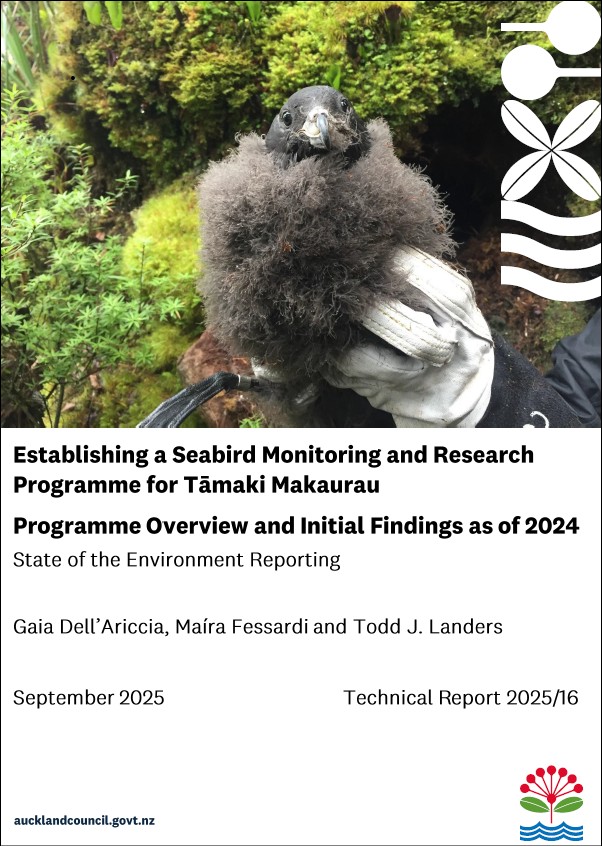Establishing a seabird monitoring and research programme for Tāmaki Makaurau. Programme overview
Author:
Gaia Dell’Ariccia, Maíra Fessardi, Todd J LandersSource:
Auckland Council Environmental Evaluation and Monitoring Unit, EEMU | Engineering, Assets and Technical Advisory DepartmentPublication date:
2025Topics:
EnvironmentEstablishing a seabird monitoring and research programme for Tāmaki Makaurau. Programme overview and initial findings as of 2024. State of the environment reporting.
Executive summary
The Tāmaki Makaurau / Auckland region is an internationally recognised hotspot for seabird diversity. Remarkably, 25 seabird species are known to breed in this region, of which 15 (60%) are Aotearoa New Zealand endemic species or subspecies. However, most of these birds are ‘Threatened’ or ‘At Risk’, requiring urgent protection, management and restoration. This led Auckland Council to establish the first local government-led regional Seabird Monitoring and Research Programme. This long-term (>10 years) programme aims to increase our knowledge on the presence, health and trends of seabird populations in the Auckland region and the factors affecting their population distributions and trends so to advise and develop restoration actions to improve their conservation statuses.
This report outlines the development of the programme, explains the rationale behind the prioritisation and choices of species and areas to monitor and research, and presents the activities carried out so far and the first results.
Using a prioritisation process, nine species were identified as having major knowledge gaps (black petrel / tākoketai/tāiko, Cook's petrel / tītī, New Zealand white-faced storm petrel / takahikare, sooty shearwater / tītī, little penguin / kororā, pied shag / kāruhiruhi, black shag / māpunga, little black shag / kawau tūī, Caspian tern / taranui) and six with a partial knowledge gap (black-winged petrel / karetai kapa mangu, fluttering shearwater / pakahā, little shag / kawaupaka, spotted shag / kawau tikitiki). Two other species were recognised as having specific interest for mana whenua, stakeholders, education, and/or research purposes (Australasian gannet / tākapu, grey-faced petrel / ōi). The study areas were selected based on their importance for seabirds and for the presence of prioritised species.
With a focus on these species and sites, several projects were initiated. While long-term monitoring and research is needed, data gathered so far are still informative. The main findings so far are listed below.
Species projects:
- The black petrel population on Hauturu is small despite high protection, showing yearly fluctuations in number of breeding birds. This population vulnerable and highly impacted by extreme weather events.
- Cook’s petrels on Hauturu are showing positive numbers of breeding birds and good breeding success, also in 2023, showing a potentially higher resilience than other species. A small part of the colony was impacted by weather events because of slips and fallen trees that destroyed it.
- A first population estimate of white-faced storm petrel breeding on Maria Island, The Noises was calculated. Despite the high level of uncertainty due to low number of repetitions, it shows that several thousands of birds are probably breeding on this island. Interannual variability in both nest occupancy and breeding success is high and the species is heavily impacted and vulnerable to extreme weather events.
- A map of shag colonies in the region was compiled. This work is not yet complete, but present findings show that pied shags are the most abundant species. However, colonies have a different distribution than past reported data. Little shag colonies are more abundant than what was previously reported. Black and little black shags are rare, but previously unreported colonies of these species are being found.
- Population counts of spotted shag reveal large variation year to year, with signs of continued decline over time. A tracking study of foraging birds is ongoing.
Site-based projects:
- Ōtata Island (The Noises) is an important seabird site. Monitoring of grey-faced petrel showed a relatively stable population, whereas little penguin were present in low numbers and only a small number of them were breeding. Trials for restoration of spotted shag, fluttering shearwater and little penguin are ongoing.
- The restoration research projects in the Waitākere ranges highlighted that grey-faced petrel can have relatively high breeding success despite the presence of introduced mammalian predators as long as these are below a certain threshold level. The most vulnerable time identified is the early chick-rearing phase. The Waitākere Ranges community are generally supportive of increased predator control and other habitat management approaches to support the restoration of grey-faced petrel.
- The pilot trial for seabird monitoring feasibility at Glenfern Sanctuary on Aotea / Great Barrier Island was successful even if first findings evidenced low numbers of occupied burrows. The employment of a seabird detector dog located more active burrows for both black and Cook’s petrel, as well as some little penguin burrow. Regular, long-term monitoring is feasible and relevant.
- The access to Pokohinu / Burgess Island was inconsistent preventing the collection of reliable data. Amongst the other seabird species that breed there, only very few burrows of black-winged petrel and only one of sooty shearwater have been found, highlighting the need for further monitoring to identify trends. Monitoring is needed for all seabird species on Pokohinu.
The Seabird Monitoring and Research Programme involved collaboration with other institutions and universities. The results from these supporting projects are provided in a specific section of this report. These include studies on stress hormones, a socio-ecological study on the perceptions of pigs and black petrels on Aotea / Great Barrier Island and the search for juvenile black petrels at sea.
New research projects are also being initiated. The Programme will integrate data from population monitoring with research on threats. This includes a study of heavy metals and other contaminants and how they affect the health status of seabird populations. Another study on the effects of temperature on breeding aims to understand potential impacts on populations in a scenario of global climate warming.
Auckland Council technical report, TR2025/16
September 2025
See also
